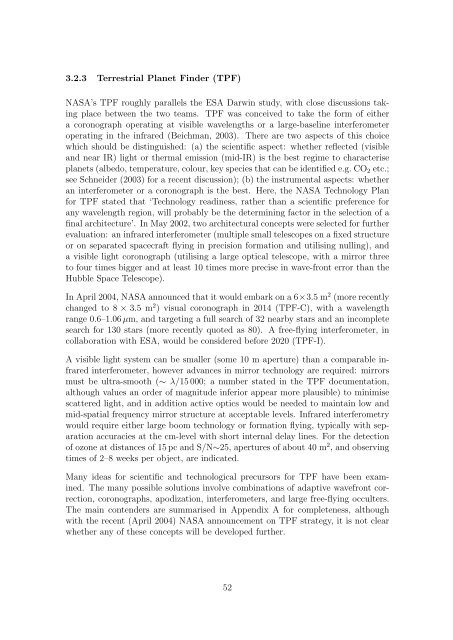Report - School of Physics
Report - School of Physics
Report - School of Physics
You also want an ePaper? Increase the reach of your titles
YUMPU automatically turns print PDFs into web optimized ePapers that Google loves.
3.2.3 Terrestrial Planet Finder (TPF)<br />
NASA’s TPF roughly parallels the ESA Darwin study, with close discussions taking<br />
place between the two teams. TPF was conceived to take the form <strong>of</strong> either<br />
a coronograph operating at visible wavelengths or a large-baseline interferometer<br />
operating in the infrared (Beichman, 2003). There are two aspects <strong>of</strong> this choice<br />
which should be distinguished: (a) the scientific aspect: whether reflected (visible<br />
and near IR) light or thermal emission (mid-IR) is the best regime to characterise<br />
planets (albedo, temperature, colour, key species that can be identified e.g. CO 2 etc.;<br />
see Schneider (2003) for a recent discussion); (b) the instrumental aspects: whether<br />
an interferometer or a coronograph is the best. Here, the NASA Technology Plan<br />
for TPF stated that ‘Technology readiness, rather than a scientific preference for<br />
any wavelength region, will probably be the determining factor in the selection <strong>of</strong> a<br />
final architecture’. In May 2002, two architectural concepts were selected for further<br />
evaluation: an infrared interferometer (multiple small telescopes on a fixed structure<br />
or on separated spacecraft flying in precision formation and utilising nulling), and<br />
a visible light coronograph (utilising a large optical telescope, with a mirror three<br />
to four times bigger and at least 10 times more precise in wave-front error than the<br />
Hubble Space Telescope).<br />
In April 2004, NASA announced that it would embark on a 6×3.5 m 2 (more recently<br />
changed to 8 × 3.5 m 2 ) visual coronograph in 2014 (TPF-C), with a wavelength<br />
range 0.6–1.06 µm, and targeting a full search <strong>of</strong> 32 nearby stars and an incomplete<br />
search for 130 stars (more recently quoted as 80). A free-flying interferometer, in<br />
collaboration with ESA, would be considered before 2020 (TPF-I).<br />
A visible light system can be smaller (some 10 m aperture) than a comparable infrared<br />
interferometer, however advances in mirror technology are required: mirrors<br />
must be ultra-smooth (∼ λ/15 000; a number stated in the TPF documentation,<br />
although values an order <strong>of</strong> magnitude inferior appear more plausible) to minimise<br />
scattered light, and in addition active optics would be needed to maintain low and<br />
mid-spatial frequency mirror structure at acceptable levels. Infrared interferometry<br />
would require either large boom technology or formation flying, typically with separation<br />
accuracies at the cm-level with short internal delay lines. For the detection<br />
<strong>of</strong> ozone at distances <strong>of</strong> 15 pc and S/N∼25, apertures <strong>of</strong> about 40 m 2 , and observing<br />
times <strong>of</strong> 2–8 weeks per object, are indicated.<br />
Many ideas for scientific and technological precursors for TPF have been examined.<br />
The many possible solutions involve combinations <strong>of</strong> adaptive wavefront correction,<br />
coronographs, apodization, interferometers, and large free-flying occulters.<br />
The main contenders are summarised in Appendix A for completeness, although<br />
with the recent (April 2004) NASA announcement on TPF strategy, it is not clear<br />
whether any <strong>of</strong> these concepts will be developed further.<br />
52
















